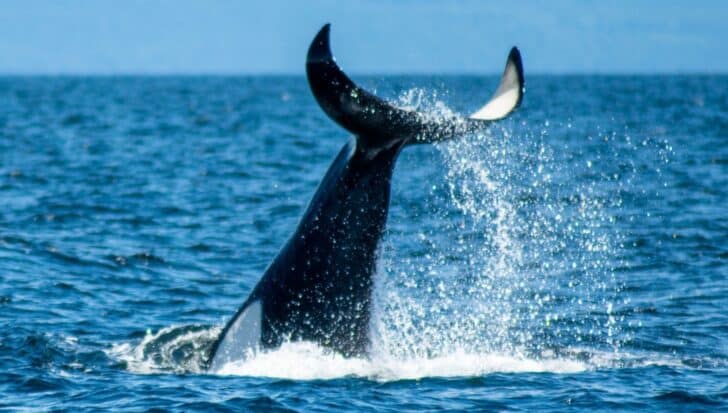Orcas might be called killer whales, but that’s only part of the story.
These so-called whales are among the smartest creatures in the sea, with fascinating language and hunting abilities.
They live in tight-knit families, pass down traditions, and sometimes do things so bizarre that even scientists are left scratching their heads.
Now that we’ve got your attention, let’s dive straight into these orca facts!
Orcas (Orcinus orca) are actually members of the dolphin family, and the largest of them all! They’re also a toothed whale, along with others like porpoises and sperm whales.
Orcas never fully fall asleep; instead, they rest one half of their brain at a time while keeping one eye open to breathe and watch for danger.
An adult male orca can reach up to about 32 ft (9.8 m) in length and weigh as much as 11 tons (10 metric tonnes). Females tend to be smaller, generally reaching up to about 23 feet (7 m) and weighing around 3 to 4 tons (2.7–3.6 metric tonnes).
Male orcas typically live to around thirty years old, and up to a maximum of 60, with females living an extra twenty years.
Orcas are apex predators, meaning they sit at the top of the food chain and have no natural predators when fully grown.
An orca’s diet is extremely varied, and includes fish, squid, seals, sea lions, penguins, seabirds, other whales, and occasionally even sharks.
Some orca populations specialize in particular prey types: for example, certain groups mainly eat fish, while others specialize in marine mammals.
In parts of Australia, researchers have documented orcas preying on great white sharks and selectively consuming their livers.
Orcas have about 40 to 50 teeth (roughly 45), each about 3 inches (7.6 centimeters) long, that help them grip onto their prey.
Instead of chewing, orcas sometimes swallow small prey whole, and for larger prey, they tear them into pieces.
These powerful predators are surprisingly social, living in pods of up to 40 orcas. Each pod is like a close-knit family that hunts, travels, and plays together for life.
The core orca social unit is often matrilineal, and because orcas live so long, a matriarch often lives with multiple generations of her offspring, both sons and daughters.
Pods of orcas form larger groupings of clans and communities, sometimes based on vocal dialects and shared ancestry.
Each orca pod tends to have a distinctive set of vocal calls (dialect), combinations of different sounds like whistles and clicks that its members recognize and use to communicate.
Orcas have been seen making out with each other, or at least nibbling on each other’s tongues. Either way, it’s thought to be for social bonding.
Orcas are the first marine animals known to use tools! They were observed off the coast of the US and Canada breaking off kelp and using it as a grooming tool to remove dead skin.
Proving that trends truly never disappear, multiple times, and decades apart, certain orca pods in the Pacific Ocean have started wearing salmon on their heads as hats.
Some Iberian orcas have developed a novel behavior of ramming or biting the rudders of boats, targeting sailboats in the Strait of Gibraltar and nearby coasts.
Because orcas are so socially and culturally complex, with their dialects and the transmission of trendy behaviors like wearing salmon hats, scientists study them as examples of animal culture in nature.

Orcas aren’t really whales, and calling them killers doesn’t get you very far either.
They hunt with precision, live in families, speak in dialects, and sometimes wear fish on their heads. They’re smart, social, and not above being strange.
Some behaviours make them seem more human. Others remind you they’re something else entirely.
If nothing else, they prove that intelligence in the animal world doesn’t always look how we expect it to.
